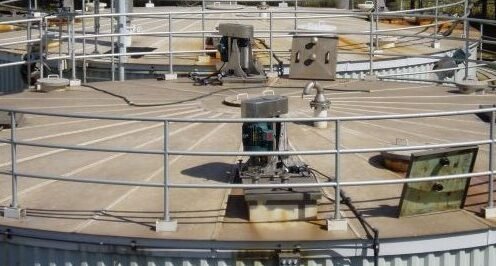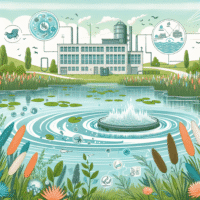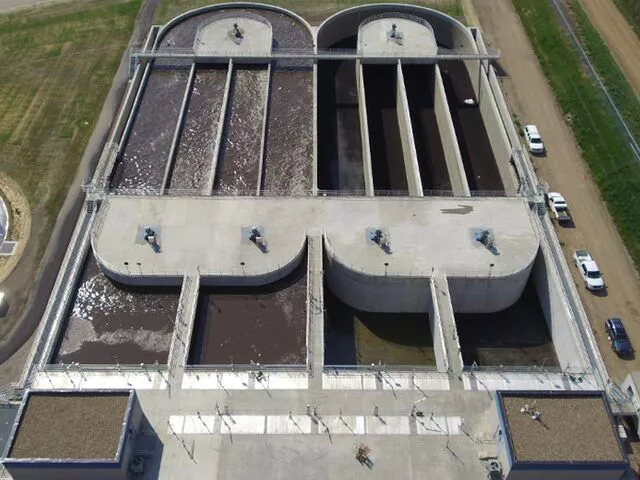Thermophilic Digestion: Optimizing Waste Treatment Efficiency

Thermophilic digestion is a process that breaks down organic matter at high temperatures. It happens in special tanks called digesters. These tanks are kept warm, usually between 50-60°C. This heat helps certain bacteria grow and work faster.
The main benefit of thermophilic digestion is that it can process waste more quickly than other methods. This means it can handle more waste in less time. It also kills more harmful germs, making the end product safer to use.
This process is used in many places. Farms use it to deal with animal waste. Cities use it to treat sewage. Food companies use it to handle leftover organic matter. The end product can be used as fertilizer or to make biogas for energy.
Key Takeaways
- Thermophilic digestion breaks down organic waste at high temperatures
- It produces safe, usable end products like fertilizer and biogas
- This method is faster and more efficient than other waste treatment processes
Fundamentals of Thermophilic Digestion
Thermophilic digestion is a key process in waste treatment and biogas production. It operates at higher temperatures than traditional methods, offering unique advantages and challenges.
Definition and Overview
Thermophilic digestion is a biological process that breaks down organic matter at temperatures between 50°C and 60°C. This method uses heat-loving microorganisms to decompose complex organic compounds into simpler forms.
The process occurs in sealed tanks called digesters. These tanks maintain high temperatures and exclude oxygen. Inside, bacteria convert organic waste into biogas and nutrient-rich digestate.
Key benefits of thermophilic digestion include:
- Faster breakdown of organic matter
- Higher biogas production
- Better pathogen reduction
- Improved nutrient availability in digestate
Thermophilic vs. Mesophilic Digestion
Thermophilic digestion differs from mesophilic digestion in several ways. The main difference is the operating temperature. Mesophilic systems run at 35°C to 40°C, while thermophilic systems operate at higher temperatures.
Thermophilic digestion offers faster processing times. It can break down organic matter in 10-15 days, compared to 20-30 days for mesophilic systems. This leads to smaller reactor sizes and higher throughput.
Thermophilic systems also achieve better pathogen reduction. The high temperatures kill more harmful bacteria. This makes the resulting digestate safer for use as fertilizer.
However, thermophilic systems require more energy to maintain high temperatures. They are also more sensitive to environmental changes and may need more careful monitoring.
Types of Thermophilic Digestion
Thermophilic digestion uses high temperatures to break down organic matter. It comes in two main forms that differ in their use of oxygen and microbial processes.
Thermophilic Aerobic Digestion
This type uses oxygen and heat-loving microbes to break down waste. It’s fast and produces less odor than other methods.
Autothermal thermophilic aerobic digestion (ATAD) is a key subtype. It maintains high temps without external heating. The process creates enough heat on its own to keep things hot.
ATAD systems use air pumps to supply oxygen. They mix the contents to spread heat and microbes. This leads to quick breakdown of organics.
The high heat kills many pathogens. This makes the end product safer to use as fertilizer. But it uses more energy than some other methods.
Thermophilic Anaerobic Digestion
This process breaks down waste without oxygen at high temps. It’s used for various organic materials like food scraps and manure.
The lack of oxygen lets special microbes thrive. These produce biogas, a mix of methane and CO2. The biogas can be used for energy.
This method works well for high-strength wastes. It can handle more material in less time than cooler processes.
The high heat also kills many harmful germs. But it can be tricky to keep stable. Sudden temp changes can upset the microbes.
Thermophilic Digestion Process
Thermophilic digestion is a high-temperature process that breaks down organic waste. It happens at temperatures between 50-60°C (122-140°F). This method speeds up waste breakdown and kills more harmful germs than cooler methods.
Stages of Digestion
The thermophilic digestion process has four main stages. First is hydrolysis, where complex molecules break into simpler ones. Bacteria release enzymes to do this job.
Next comes acidogenesis. Here, the simple molecules turn into organic acids, alcohols, and gases. This stage creates food for the next group of microbes.
The third stage is acetogenesis. Acid-forming bacteria make acetate, carbon dioxide, and hydrogen. These products feed the final stage’s microbes.
Lastly, methanogenesis occurs. Special bacteria called methanogens make biogas. This gas is mostly methane and carbon dioxide. It can be used as a renewable energy source.
Temperature and Process Control
Keeping the right temperature is crucial for thermophilic digestion. The ideal range is 50-60°C (122-140°F). This heat helps break down waste faster and kill more pathogens.
Operators must watch the temperature closely. If it drops, the process slows down. If it gets too hot, it can kill helpful bacteria. Good insulation and heating systems are important.
pH levels also need careful control. The best pH is between 6.5 and 8.0. Operators add chemicals if needed to keep the pH balanced.
Mixing is another key factor. It spreads out nutrients and keeps solids from settling. This helps the bacteria work better and makes more biogas.
Applications of Thermophilic Digestion
Thermophilic digestion offers key benefits in energy production and waste management. This process harnesses high temperatures to break down organic materials efficiently.
Energy Production
Thermophilic digestion produces biogas, a valuable energy source. This gas, rich in methane, can be used to generate electricity or heat. Power plants often use this method to create renewable energy.
The process yields more biogas than mesophilic digestion. It also produces gas faster, increasing overall efficiency. Many facilities use combined heat and power systems to maximize energy output.
Farmers can use thermophilic digestion to power their operations. They convert animal waste into usable energy. This reduces their reliance on fossil fuels and cuts costs.
Waste Management
Thermophilic digestion helps manage organic waste effectively. It breaks down waste faster than other methods. This speeds up the treatment process in waste facilities.
The high heat kills more pathogens. This makes the end product safer for use as fertilizer. Many cities use this method to treat sewage sludge.
Food processing plants benefit from thermophilic digestion. They can treat their organic waste on-site. This reduces the amount sent to landfills.
The process also helps with odor control. It breaks down odor-causing compounds more completely. This is especially useful in densely populated areas.
Challenges and Considerations
Thermophilic digestion offers benefits but comes with key challenges. Process stability and economic factors require careful management for successful implementation.
Process Stability
Thermophilic digestion operates at high temperatures between 50-60°C. This makes the process sensitive to temperature changes. Even small fluctuations can disrupt microbial activity.
Maintaining a stable environment is crucial. Operators must closely monitor and control:
- pH levels
- Organic loading rates
- Mixing intensity
Rapid changes in these factors can lead to system failure. Thermophilic microbes are less diverse than mesophilic ones. This makes them more vulnerable to toxins or inhibitors in the feedstock.
Proper startup procedures are vital. The transition from mesophilic to thermophilic conditions must be gradual to allow microbial adaptation.
Economic Aspects
Thermophilic digestion systems have higher upfront costs. They require:
- Advanced heating systems
- More robust equipment
- Skilled operators
Energy needs for heating are significant. This impacts operational expenses. However, faster treatment times can offset some costs.
The process produces more biogas than mesophilic digestion. This can be used to generate heat and electricity, improving energy balance.
Market demand for the end products (biogas and digestate) affects economic viability. Local regulations on waste management and renewable energy incentives play a crucial role in the financial outlook.
Advancements and Innovations
Recent breakthroughs have improved thermophilic digestion efficiency and expanded its applications. New technologies and potential future developments show promise for wider adoption of this process.
Technological Developments
Thermophilic digestion has seen major advances in recent years. Researchers have developed more efficient reactor designs that increase biogas production and pathogen removal. One example is the thermophilic upflow anaerobic sludge blanket (UASB) reactor.
This reactor type can treat blackwater at 55°C, effectively eliminating pathogens while maintaining high methane output. Engineers have also created improved heat exchangers to maintain optimal temperatures.
New microbial monitoring techniques allow better control of the digestion process. These tools help operators adjust conditions to maximize performance. Automated feeding and mixing systems have increased consistency and reduced labor needs.
Future Prospects
The future of thermophilic digestion looks promising. Experts predict wider adoption in wastewater treatment and bioenergy production. Ongoing research aims to further boost efficiency and expand feedstock options.
Genetic engineering of microbes may lead to more robust digester populations. These enhanced microbes could tolerate higher temperatures and convert waste more quickly. Integration with other renewable energy systems is another area of focus.
Combining thermophilic digestion with solar or wind power could create more sustainable waste management solutions. As cities grow, compact digester designs for urban areas are likely to emerge. These may enable localized waste treatment and energy production.
Frequently Asked Questions
What are the advantages of using thermophilic digestion over mesophilic digestion?
Thermophilic digestion operates at higher temperatures, typically 50-60°C. This leads to faster reaction rates and more complete breakdown of organic matter.
The process can destroy more pathogens, resulting in a safer end product. It also allows for higher loading rates and shorter retention times in digesters.
How do thermophilic conditions affect the breakdown of organic material?
Higher temperatures speed up microbial activity and enzyme reactions. This accelerates the hydrolysis of complex organic compounds.
Thermophilic bacteria can break down some materials that mesophilic bacteria cannot. This results in more complete degradation of organic waste.
What are the optimal operating parameters for thermophilic anaerobic digesters?
The ideal temperature range is 50-60°C. pH should be maintained between 7.0 and 8.5.
Retention times are typically 10-15 days. Organic loading rates can be higher than in mesophilic systems, often 4-5 kg volatile solids/m³/day.
How does thermophilic digestion compare to mesophilic in terms of biogas production?
Thermophilic digestion generally produces more biogas per unit of organic matter. The biogas yield can be 25-50% higher than mesophilic systems. The biogas from thermophilic digestion often has a higher methane content. This increases its energy value and usefulness as a fuel.
Can thermophilic anaerobic digestion process high-strength wastes efficiently?
Yes, thermophilic digesters can handle higher organic loading rates. They're effective for processing concentrated organic wastes.
These systems can treat high-strength industrial effluents and agricultural wastes with high solid content.
What are the main challenges associated with maintaining thermophilic conditions in anaerobic digesters?
Maintaining consistent high temperatures requires more energy input. This increases operational costs compared to mesophilic systems.
Thermophilic bacteria are more sensitive to temperature fluctuations. Even small changes can disrupt the microbial community and digester performance.



